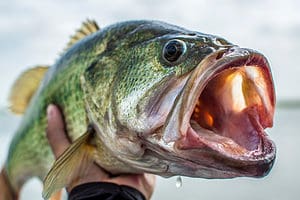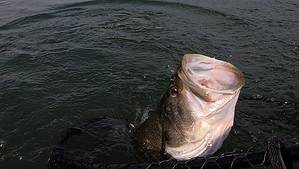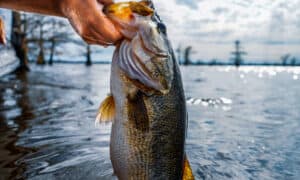Smallmouth bass (scientific name: Micropterus dolomieu) is a popular game fish species found in many freshwater bodies across the United States.
These fish are a popular target among anglers.
Smallmouth bass are known for their fighting spirit and challenging nature.
Today, we discover the largest smallmouth bass ever caught in Missouri. We also delve into the world of smallmouth bass in Missouri, exploring the many aspects of these fish that make them a sought-after fish species.
The Largest Smallmouth Bass Ever Caught in Missouri
On December 18, 1994, Kevin S. Clingan caught the largest smallmouth bass ever in Missouri at Stockton Lake. It weighed 7 lbs., 2 oz.
The Largest Smallmouth Bass Ever Caught Worldwide
In 1955, David L. Hayes caught the world’s largest smallmouth bass ever. It weighed 11 lbs., 15 oz. He caught this prized trophy at Dale Hollow Lake in Tennessee. This fish remains the world record for smallmouth bass to this day.
About Smallmouth Bass
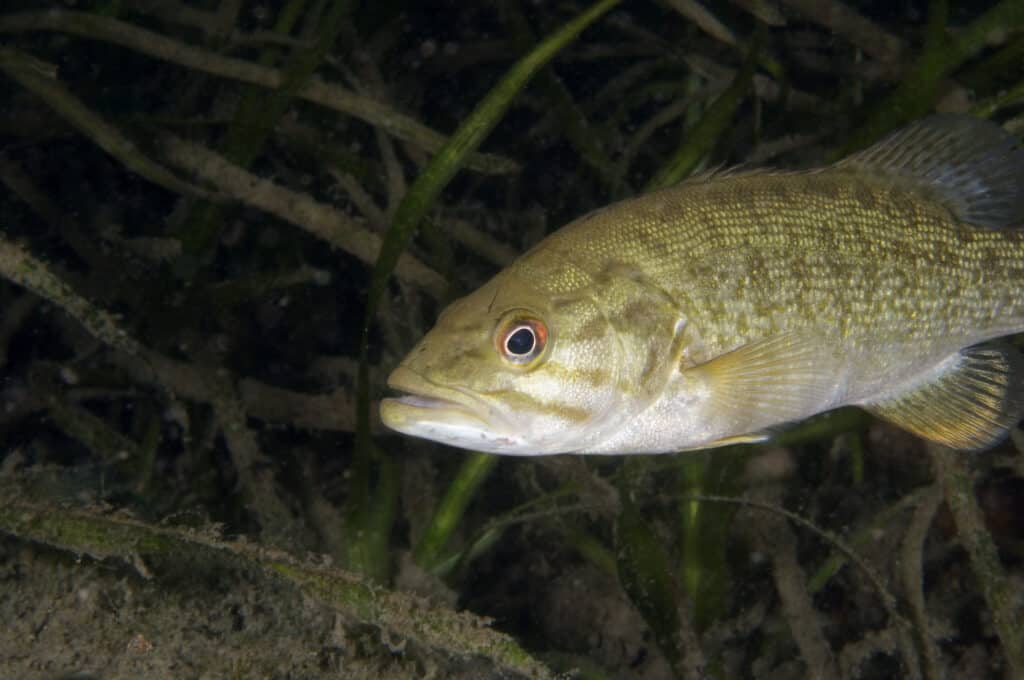
Smallmouth bass are olive-green, with vertical black bars on their sides.
©iStock.com/LaSalle-Photo
To understand the significance of smallmouth bass in Missouri, it’s important to have a background on various aspects of this species.
Physical Characteristics
Smallmouth bass are olive-green, with vertical black bars on their sides. Their streamlined body enables them to move swiftly through the water.
The fish are known for their tenacity, strength, and acrobatic nature.
Smallmouth bass are typically smaller than their cousin, the largemouth bass. Adults are 12-16 inches long.
They’re opportunistic predators that feed on a variety of prey, including crayfish, minnows, insects, and small fish.
Habitat
Smallmouth bass are most active during the day. You can find them in rivers, streams, and reservoirs throughout Missouri. They prefer clear water with rocky or sandy bottoms. You can find them near submerged rocks, logs, and other structures that provide cover and shelter.
Historical Context
Smallmouth bass were introduced to Missouri waters in the late 1800s. They have since established thriving populations.
These fish were originally found in the eastern United States. However, they were brought to Missouri due to their popularity as game fish.
Over time, smallmouth bass populations expanded throughout Missouri.
Significance of in Missouri
Smallmouth bass play an important role in Missouri’s fishing culture. Many anglers target these fish for sport and recreation.
The economic and recreational importance of smallmouth bass cannot be understated. They contribute significantly to Missouri’s economy and provide enjoyment for thousands of anglers every year.
Some popular fishing locations for smallmouth bass in Missouri include:
- The Current River
- Meramec River
- Niangua River
- Gasconade River
- Black River
- The Lake of the Ozarks
Smallmouth Bass Prey
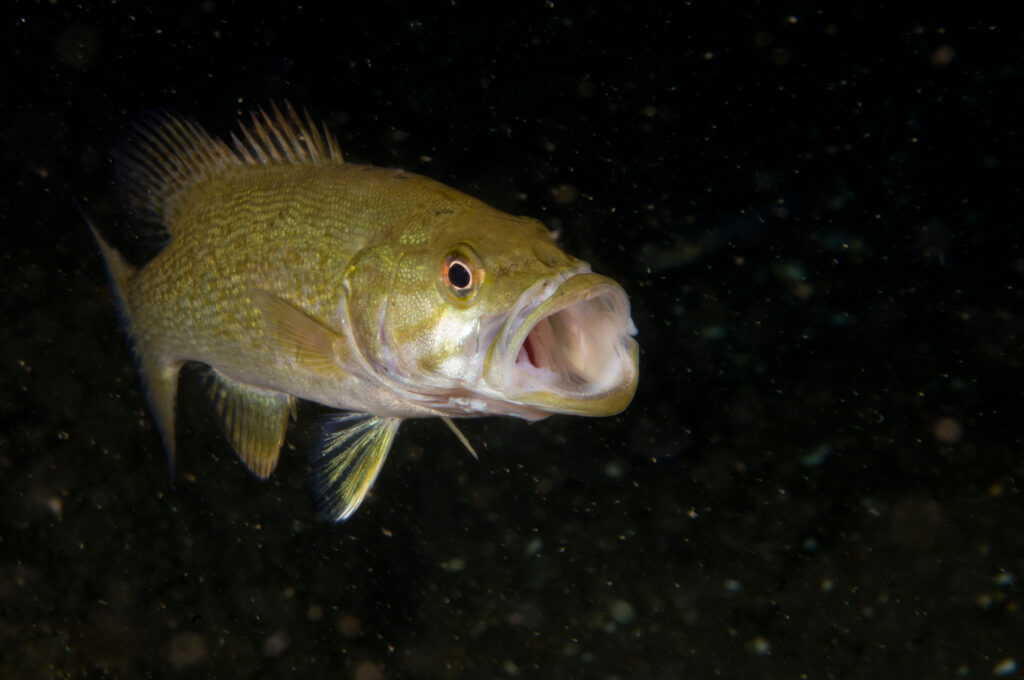
Smallmouth bass are carnivorous fish whose diet consists primarily of small fish, insects, crustaceans, and other aquatic organisms.
©RLS Photo/Shutterstock.com
They are carnivorous fish whose diet consists primarily of small fish, insects, crustaceans, and other aquatic organisms.
The specific diet of smallmouth bass can vary depending on the availability of prey in their environment, as well as their size and age.
Some common prey items include:
Minnows
Smallmouth bass will feed on various minnow species, including shiners, chubs, and darters.
Crawfish
Crawfish are a staple of a smallmouth bass diet. These crustaceans are often found in rocky areas of streams and rivers.
Insects
Smallmouth bass feed on various insects, including mayflies, caddisflies, and dragonflies.
Worms and Leeches
Smallmouth bass will also feed on worms and leeches found in the substrate of rivers and lakes.
Other Fish
They are opportunistic feeders who prey on smaller fish, such as sunfish, perch, and minnows.
Smallmouth Bass Fishing in Missouri
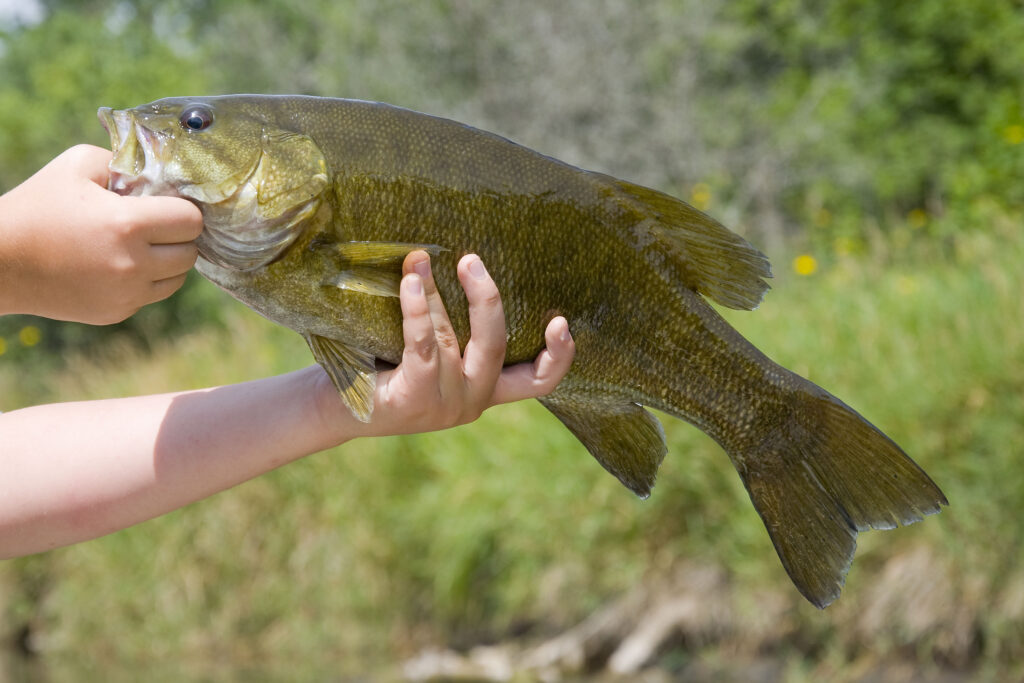
With its clear waters and rocky bottoms, Missouri provides an ideal habitat for smallmouth bass.
©Steve Oehlenschlager/Shutterstock.com
Smallmouth bass fishing is a popular pastime in Missouri. It draws anglers from all over the state and beyond. With its clear waters and rocky bottoms, Missouri provides an ideal habitat for smallmouth bass, making it a prime location for fishing enthusiasts.
Best Fishing Times
Smallmouth bass can be caught year-round in Missouri. But the best times to fish for them are in the spring and fall when they’re more active and tend to feed more aggressively.
In the spring, smallmouth bass move into shallower waters to spawn. This makes them more accessible to anglers. In the fall, smallmouth bass are preparing for winter and are more likely to be found in deeper water.
Equipment and Techniques
When fishing for smallmouth bass in Missouri, it’s important to have the right equipment and to use the appropriate techniques.
A medium to medium-heavy spinning rod and reel with 8-10 lb. test line is suitable for most smallmouth bass fishing. Anglers should use lures and baits that mimic the smallmouth bass’s natural prey, such as crayfish, minnows, and insects.
Some popular lures and baits for smallmouth bass fishing in Missouri include:
- Plastic worms
- Crankbaits
- Spinnerbaits
- Topwater lures
Live bait, such as nightcrawlers and minnows, can also be effective.
Regulations and Guidelines
Anglers should know the regulations and guidelines for fishing smallmouth bass in Missouri, including size and bag limits.
In most Missouri waters, the daily limit for smallmouth bass is one fish per day, with a minimum length limit of 15 inches.
But regulations can vary depending on the specific waterway. So, anglers should consult the Missouri Department of Conservation (MDC) for the latest information.
Catch-and-Release
Catch-and-release fishing is a popular and effective way to ensure the long-term survival of smallmouth bass populations in Missouri.
Anglers should handle fish carefully and release them quickly to minimize stress and maximize their chances of survival.
Using barbless hooks and artificial lures can also help reduce the potential for injury to the fish.
Catching and Handling Smallmouth Bass in Missouri
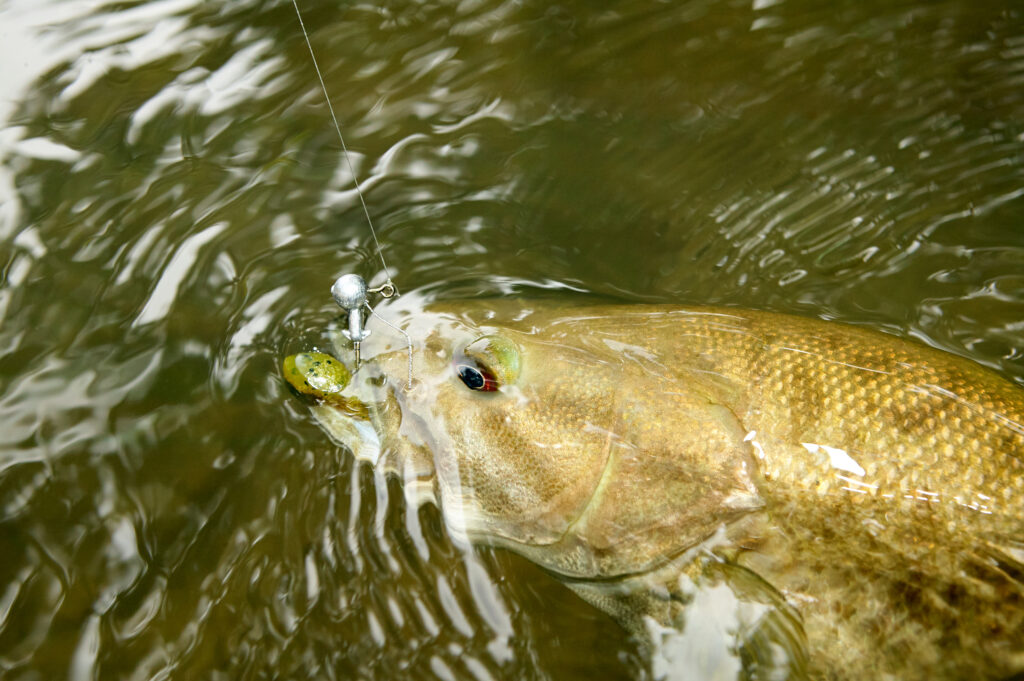
Handling smallmouth bass properly is critical to their survival.
©CLP Media/Shutterstock.com
Smallmouth bass is known for its aggressive strikes and acrobatic fights.
Catching smallmouth bass can be a thrilling experience. But it’s important to handle these fish carefully to ensure their survival.
Removing Hooks Safely
When removing hooks from smallmouth bass, do so quickly and carefully to minimize stress and injury to the fish.
Using barbless hooks can make hook removal easier and less harmful to the fish. However, if a hook is deeply embedded, it may be necessary to cut the line and leave the hook in place. Attempts to remove it may cause more harm than good.
Proper Handling
Handling smallmouth bass properly is critical to their survival.
Anglers should avoid touching the fish’s gills or eyes and hold the fish gently, supporting its weight with both hands.
Using a landing net can help minimize the handling of the fish and reduce the risk of injury.
Releasing
Releasing smallmouth bass quickly and carefully can greatly improve their chances of survival.
Anglers should minimize the time the fish spends out of the water. They should release the fish as soon as possible after removing the hook. When releasing the fish, hold it in the water and allow it to swim away on its own.
Minimizing Stress and Injury
There are several techniques that anglers can use to minimize stress and injury to smallmouth bass. These include:
- Using artificial lures and barbless hooks
- Avoiding fishing during times of high water temperature
- Not fishing in spawning areas during the spring
Smallmouth Bass Conservation Efforts in Missouri
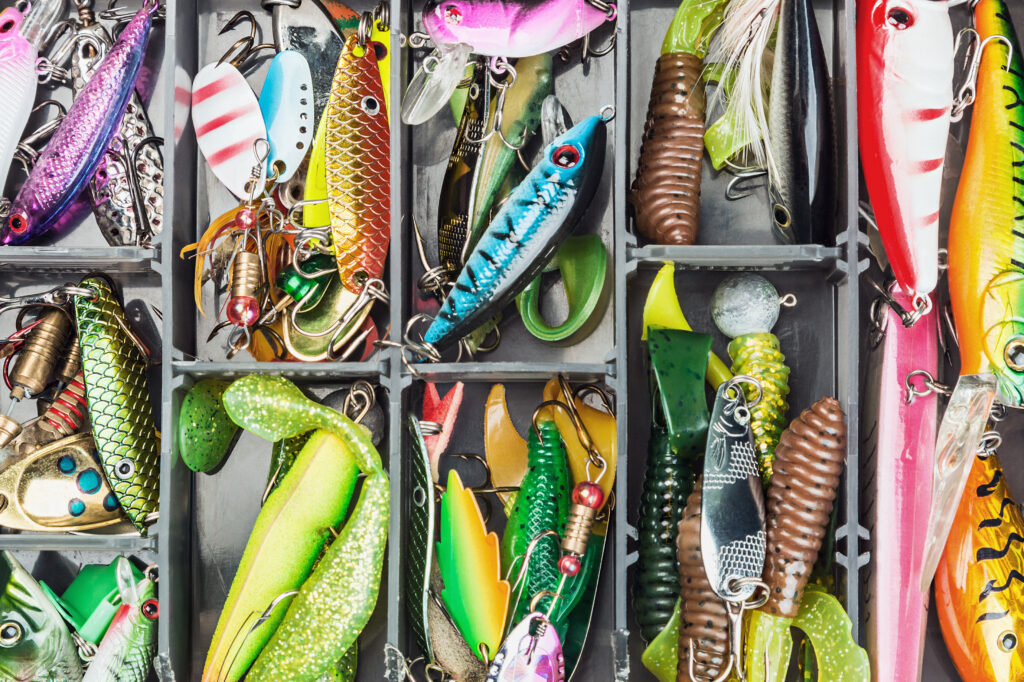
Using artificial lures and barbless hooks Is one of several ways to practice sustainable fishing.
©OlegDoroshin/Shutterstock.com
Smallmouth bass are an important game fish in Missouri. That’s why efforts are being made to ensure their populations remain healthy and sustainable. Let’s discuss the conservation efforts being undertaken to protect smallmouth bass in Missouri.
Habitat Restoration
Habitat restoration is an important part of smallmouth bass conservation efforts in Missouri. It involves restoring the natural river and stream habitats that human activities have altered or damaged.
Efforts are being made to restore riparian zones, improve water quality, and remove barriers to fish passage. All these can help create better habitats for smallmouth bass.
Stocking Programs
Stocking programs are another important conservation effort for smallmouth bass in Missouri. MDC conducts regular stocking programs in various streams and rivers throughout the state to supplement the natural populations of smallmouth bass.
These programs are carefully managed to ensure that the stocked fish are healthy and can survive in their new environments.
Research Initiatives
Research initiatives are also being undertaken to better understand the biology and ecology of smallmouth bass in Missouri. This includes studies on population dynamics, habitat use, and genetics.
This research can help inform management decisions and conservation efforts, ensuring that smallmouth bass populations remain healthy and sustainable.
Regulations and Guidelines
Regulations and guidelines are in place to help protect smallmouth bass populations in Missouri. This includes:
- Size and bag limits
- Seasonal closures
- Special regulations for certain bodies of water.
Anglers should be aware of these regulations and guidelines and follow them to help protect smallmouth bass populations.
Public Education and Outreach
Public education and outreach are important components of smallmouth bass conservation efforts in Missouri.
The MDC and other organizations provide educational resources and outreach programs to promote the conservation and sustainable use of smallmouth bass populations.
This includes education on catch-and-release fishing, habitat conservation, and responsible angling practices.
Importance of Sustainable Fishing Practices for Smallmouth Bass
Sustainable fishing practices are important for protecting smallmouth bass populations in Missouri and ensuring their long-term survival.
These practices can include:
- Catch-and-release fishing
- Using artificial lures and barbless hooks
- Following regulations regarding size and bag limits
Anglers and other stakeholders can also play a role in promoting sustainable fishing practices and protecting smallmouth bass populations in Missouri. This can include:
- Participating in conservation efforts
- Supporting regulations and policies that protect smallmouth bass populations
Spreading awareness about the importance of sustainable fishing
Threats to Smallmouth Bass in Missouri
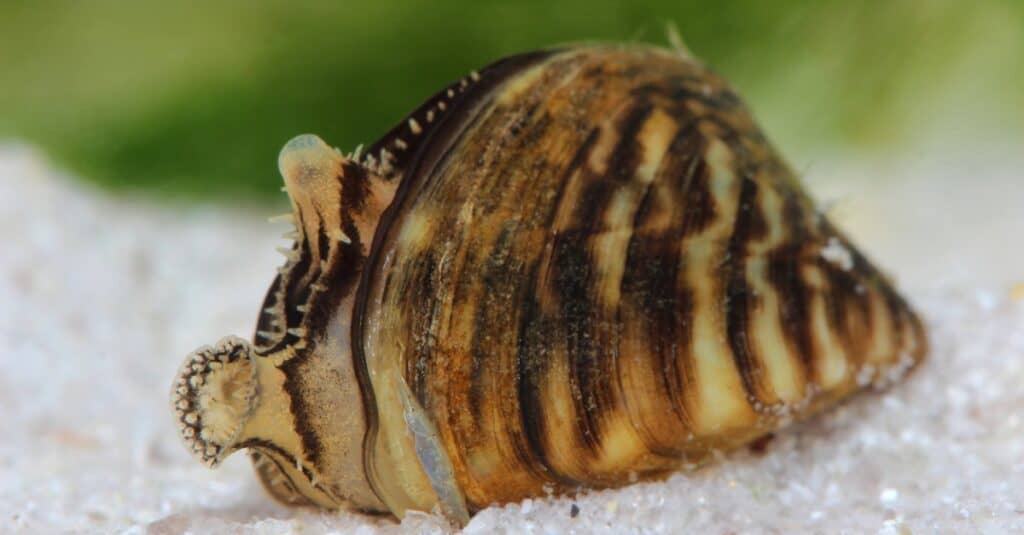
Non-native species such as
zebra musselscan outcompete smallmouth bass for food and habitat, declining their populations.
©iStock.com/VitalisG
Despite ongoing conservation efforts, smallmouth bass populations in Missouri face several threats that could potentially harm their overall health and sustainability. Let’s discuss some of them.
Habitat Loss and Degradation
Habitat loss and degradation is a major threat to smallmouth bass populations in Missouri.
Human activities such as agriculture, urbanization, and dam construction can alter or destroy natural river and stream habitats important for smallmouth bass. This can lead to a loss of suitable spawning areas, food sources, and shelter, ultimately reducing smallmouth bass populations.
Pollution
Pollution is another significant threat to smallmouth bass in Missouri. Polluted waters can reduce dissolved oxygen levels, which can be lethal for smallmouth bass.
Additionally, pollutants such as pesticides, herbicides, and heavy metals can accumulate in the tissues of smallmouth bass. This can lead to negative health effects and reduced reproductive success.
Overfishing
This is a common threat to many fish populations, and smallmouth bass in Missouri are no exception.
Overfishing can lead to a decline in smallmouth bass populations, reduced genetic diversity, and smaller average fish sizes.
Anglers can help prevent overfishing by:
- Following regulations and guidelines
- Practicing catch-and-release fishing
- Avoiding high-pressure fishing areas
Invasive Species
Invasive species are another major threat to smallmouth bass populations in Missouri.
Non-native species such as zebra mussels and Asian carp can outcompete smallmouth bass for food and habitat, declining their populations.
Additionally, invasive species can carry diseases and parasites that can harm smallmouth bass and other native species.
Where is Stockton Lake Located on a Map?
Situated in southeastern Cedar County, northeastern Dade County, and southwestern Polk County, Missouri, Stockton Lake is an expansive reservoir with a distinctive ‘V’ shape, spanning 39 square miles and boasting an impressive shoreline stretching 298 miles, complemented by three marinas and ten public-use areas.
Here is Stockton Lake on a map:
Key Takeaways
Smallmouth bass fishing is popular in Missouri for anglers of all skill levels. The state’s numerous lakes, rivers, and streams provide ample opportunities to catch this prized game fish. But, as with all fishing activities, practice responsible and sustainable fishing practices to protect the smallmouth bass population and its ecosystem.
To ensure the continued health and well-being of smallmouth bass in Missouri, adhere to MDC’s regulations and guidelines. This includes following catch limits, properly handling and releasing fish not kept for consumption, and reporting illegal or harmful fishing practices.
Additionally, it’s important to recognize the value of smallmouth bass as a food source. By properly cleaning, preparing, and cooking smallmouth bass, anglers can enjoy a delicious and healthy meal.
The photo featured at the top of this post is © CSNafzger/Shutterstock.com
Thank you for reading! Have some feedback for us? Contact the AZ Animals editorial team.



